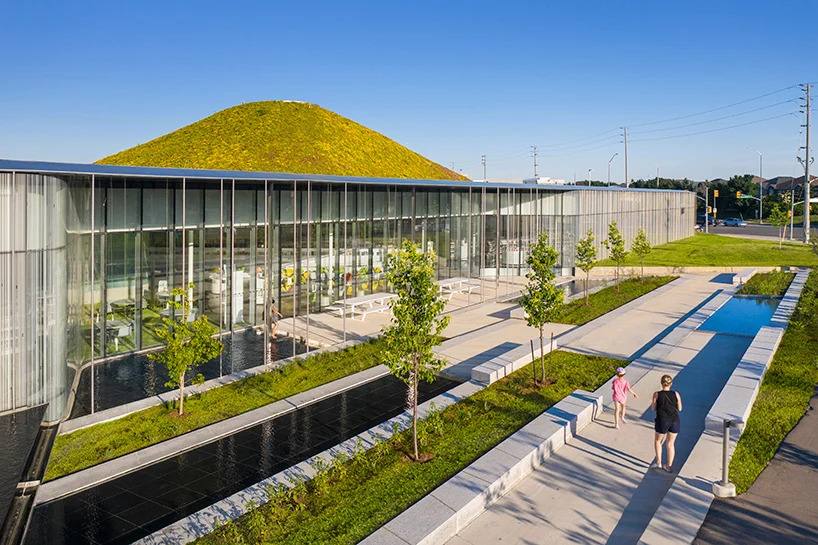In Ontario’s city of Brampton, the Springdale Library and Komagata Maru Park by RDH Architects (RDHA) introduces an inclusive gathering place, a counterpoint to the otherwise flat suburban area, and a point of pride for the Canadian city.
The project site was physically constrained, framed by a commercial plaza to the east, a main road to the south, and a natural ravine to the north and west. The architects positioned the library as close to the street as possible, in order to solidify the building’s presence with the street, preserve the site’s natural topography and irrigation patterns, and channel interior views towards the ravine. This siting also maximized room in the rear for a neighborhood park, and a parking and drop-off sequence with a canopied entry forecourt.
RDHA designs Ontario’s Springdale Library to not only introduce a building, but to establish a landscape — from the organically shaped perimeter that joins building and courtyards, the creation of an undulating topography between the fluidly shaped ceiling and mountainous green roof, and the sloping floor slab of the interior and the flat landscape of the park. The park is comprised of a series of terraced contemplative gardens for older users as well as a splash-pad and children’s play area organized around the word ‘imagine.’ The five-meter-high letters are oriented in both horizontal and vertical planes and become an interactive feature for the children to discover.
The interior program of RDHA’s Springdale Library and Komagata Maru Park is comprised of 20,000 square feet of library program space, combined with a 5,000 square foot community multi-purpose room. Each element of the library, detailed in scope, highlights RDHA’s practice of applying conventional budgets and materials to design unconventional buildings. For example, Springdale’s oculi, fashioned from perforated drywall fixed to off-the-shelf framing components, temper the noise levels and the way that light spreads within the library, to inspire a sense of awe and wonder — and an unusual sense of shelter and togetherness.
With the Springdale Library in Ontario, RDHA design principal Tyler Sharp collaborates with Brady Peters, a generative design specialist at the university of Toronto. The collaboration saw the generation of a solar-responsive ceramic frit pattern on the building’s windows. Its striated patterns range from white to dark grey expanding and contracting based on solar orientations, while also visually merging with a series of stainless steel rods that add an additional layer of solar resistance while supporting the glazed units and forming the courtyard enclosures. These elements are conceived as a functional abstraction of two combined metaphors: the turning pages of a library book and the trunks of trees in a forest.
YAKETY YAK Furniture Blog, mostly about cool libraries, furniture and design – keeping you abreast of our world. (Source: Design Boom. Images by Nic Lehoux).
















